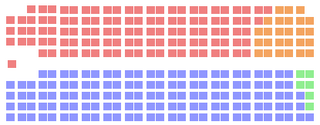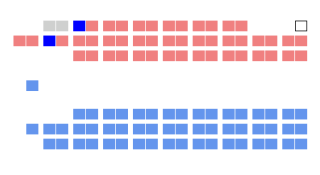By-elections to the 31st Canadian Parliament were held to fill vacancies in the House of Commons of Canada between the 1979 federal election and the 1980 federal election. The Progressive Conservative Party of Canada led a minority government for the entirety of the 31st Canadian Parliament.
Two seats became vacant during the 67-day Parliament, both were filled through by-elections.
| By-election | Date | Incumbent | Party | Winner | Party | Cause | Retained | ||
|---|---|---|---|---|---|---|---|---|---|
| Prince Albert | November 19, 1979 | John Diefenbaker | Progressive Conservative | Stan Hovdebo | New Democratic | Death (heart attack) | No | ||
| Burin—St. George's | September 19, 1979 | Don Jamieson | Liberal | Roger Simmons | Liberal | Resignation | Yes | ||
A by-election, also spelled bye-election and also known as a special election or a bypoll (India), is an election used to fill an office that has become vacant between general elections.

The 31st Canadian Parliament was a briefly lived parliament in session from October 9 until December 14, 1979. The membership was set by the 1979 federal election on May 22, 1979, and it was dissolved after the minority government of Joe Clark failed to pass a Motion of Confidence on December 13, 1979. The dissolution of parliament led to the 1980 federal election. Lasting only 66 days from first sitting to dissolution, and only nine months from election to election, the 31st was the shortest parliament in Canadian history.

The 40th Canadian Parliament was in session from November 18, 2008 to March 26, 2011, and was the last Parliament of the longest-running minority government in Canadian history that began with the previous Parliament. The membership of its House of Commons was determined by the results of the 2008 federal election held on October 14, 2008. Its first session was then prorogued by the Governor General on December 4, 2008, at the request of Prime Minister Stephen Harper, who was facing a likely no-confidence motion and a coalition agreement between the Liberal party and the New Democratic Party with the support of the Bloc Québécois. Of the 308 MPs elected at the October 14, 2008 general election, 64 were new to Parliament and three sat in Parliaments previous to the 39th: John Duncan, Jack Harris, and Roger Pomerleau.
By-elections to the 40th Canadian Parliament were held to fill vacancies in the House of Commons of Canada between the 2008 federal election and the 2011 federal election. The Conservative Party of Canada led a minority government for the entirety of the 40th Canadian Parliament, with little change from by-elections.
By-elections to the 36th Canadian Parliament were held to fill vacancies in the House of Commons of Canada between the 1997 federal election and the 2000 federal election. The Liberal Party of Canada led a majority government for the entirety of the 36th Canadian Parliament, with increases from by-elections.
By-elections to the 35th Canadian Parliament were held to fill vacancies in the House of Commons of Canada between the 1993 federal election and the 1997 federal election. The Liberal Party of Canada led a majority government for the entirety of the 35th Canadian Parliament, with little change from by-elections.
By-elections to the 34th Canadian Parliament were held to fill vacancies in the House of Commons of Canada between the 1988 federal election and the 1993 federal election. The Progressive Conservative Party of Canada led a majority government for the entirety of the 34th Canadian Parliament, though their number did decrease from by-elections.
By-elections to the 33rd Canadian Parliament were held to fill vacancies in the House of Commons of Canada between the 1984 federal election and the 1988 federal election. The Progressive Conservative Party of Canada led a majority government for the entirety of the 33rd Canadian Parliament, though their number did decrease from by-elections.
By-elections to the 32nd Canadian Parliament were held to fill vacancies in the House of Commons of Canada between the 1980 federal election and the 1984 federal election. The Liberal Party of Canada led a majority government for the entirety of the 32nd Canadian Parliament, though their number did decrease from by-elections.
By-elections to the 30th Canadian Parliament were held to fill vacancies in the House of Commons of Canada between the 1974 federal election and the 1979 federal election. The Liberal Party of Canada led a majority government for the entirety of the 30th Canadian Parliament, though their number did decrease from by-elections.
By-elections to the 28th Canadian Parliament were held to fill vacancies in the House of Commons of Canada between the 1968 federal election and the 1972 federal election. The Liberal Party of Canada led a majority government for the entirety of the 29th Canadian Parliament, though their number did decrease from by-elections.
By-elections to the 27th Canadian Parliament were held to fill vacancies in the House of Commons of Canada between the 1965 federal election and the 1968 federal election. The Liberal Party of Canada led a minority government for the entirety of the 27th Canadian Parliament, with little change from by-elections.
By-elections to the 26th Canadian Parliament were held to fill vacancies in the House of Commons of Canada between the 1963 federal election and the 1965 federal election. The Liberal Party of Canada led a minority government for the entirety of the 26th Canadian Parliament, with no change from by-elections.
By-elections to the 24th Canadian Parliament were held to fill vacancies in the House of Commons of Canada between the 1958 federal election and the 1962 federal election. The Progressive Conservative Party of Canada led a majority government for the 24th Canadian Parliament.
By-elections to the 23rd Canadian Parliament were held to fill vacancies in the House of Commons of Canada between the 1957 federal election and the 1958 federal election. The Progressive Conservative Party of Canada led a minority government for the 23rd Canadian Parliament.
By-elections to the 22nd Canadian Parliament were held to fill vacancies in the House of Commons of Canada between the 1953 federal election and the 1957 federal election. The Liberal Party of Canada led a majority government for the 22nd Canadian Parliament.
By-elections to the 21st Canadian Parliament were held to fill vacancies in the House of Commons of Canada between the 1949 federal election and the 1953 federal election. The Liberal Party of Canada led a majority government for the 21st Canadian Parliament.
By-elections to the 20th Canadian Parliament were held to fill vacancies in the House of Commons of Canada between the 1945 federal election and the 1949 federal election. The Liberal Party of Canada led a working majority government for the 20th Canadian Parliament, though was technically a minority government during World War II.
By-elections to the 19th Canadian Parliament were held to fill vacancies in the House of Commons of Canada between the 1940 federal election and the 1945 federal election. The Liberal Party of Canada led a majority government for the 19th Canadian Parliament.
By-elections to the 18th Canadian Parliament were held to fill vacancies in the House of Commons of Canada between the 1935 federal election and the 1940 federal election. The Liberal Party of Canada led a majority government for the 18th Canadian Parliament.